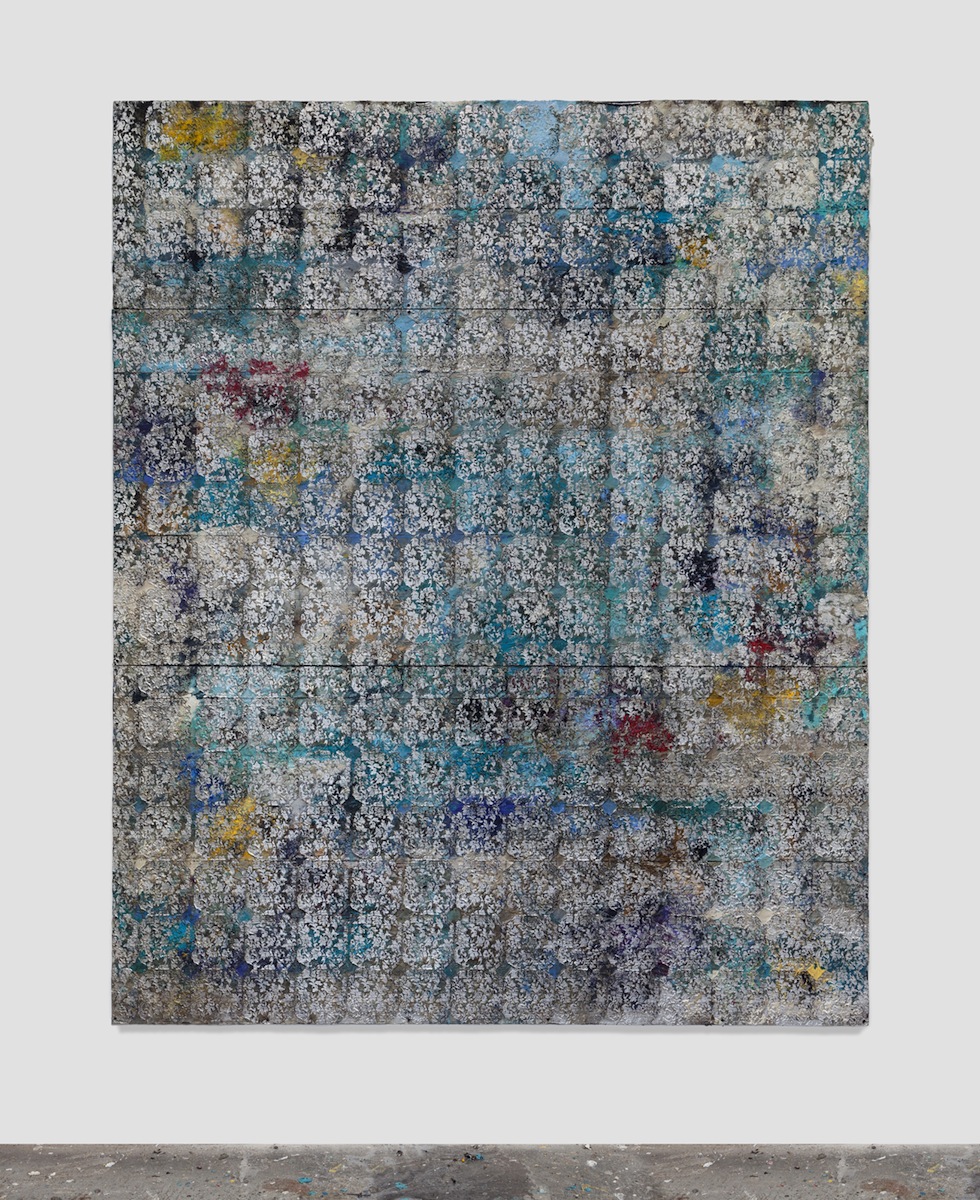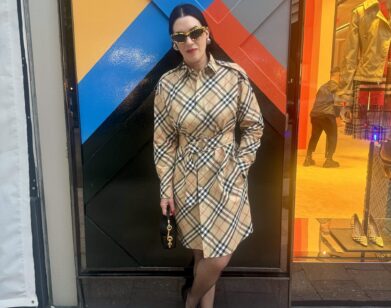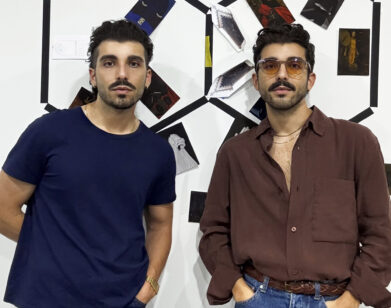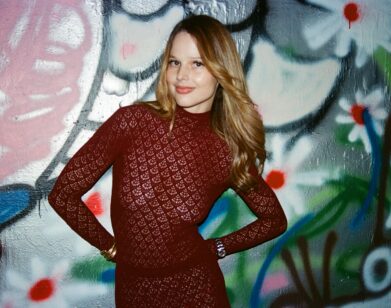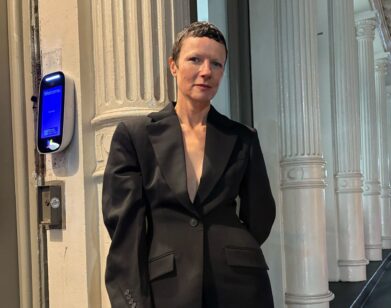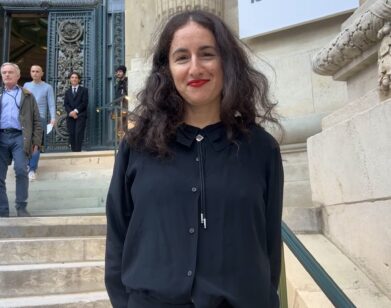A Room Full of Roof: Hugo McCloud
To reach Hugo McCloud’s studio, you must walk through AP Café in Bushwick. The café, which is airy and elegant, is of McCloud’s own design, including a copper floor-to-ceiling fountain near the entrance. It so happens that fountains hearken to McCloud’s career beginnings–the 34-year-old artist started in the design industry devising and constructing them, after learning how they worked at his mother’s Redwood City, California design store.
Beyond the fountain, his studio is through a hidden doorway in the café’s back wall. This entryway is rather emblematic of McCloud’s present. Having transitioned from design to fine art over the last decade, the artist has recently been using building materials like sheets of tar. His latest series is embedded in the ornate Edwardian wall molding at Vladimir Restoin Roitfeld’s gallery on Manhattan’s Upper East Side.
Swirling with color, some embossed with woodblock prints he learned about in India, it’s a curious and absorbing series of patterns McCloud’s produced. The canvases themselves are tar paper coated in aluminum paint, materials used on New York rooftops. On top of that, he applies traditional pigments. A few are inspired by images, he explains, including Kehinde Wiley’s cover art for the Santigold album Master of My Make-Believe. Another, with patchy florets, is an abstraction of a dress. He pulls other pictures from Instragram. “I follow a lot of people that are designers, creative people or people that post amazing pictures,” he says.
Within the New York art world microcosm, McCloud has come from nowhere; but the artist has been a long time in the making. He studied business administration for three years in college—something it’s clear has helped him as he talks about maintaining a studio in New York—before dropping out to make fountains and then furniture. That evolved into a full-blown design practice, as requests for single objects grew into requests that McCloud conceive entire spaces. On the job he noticed elements, like copper, tar paper, and steel, in their “raw states.” He started dabbling in fine art around 2001, and moved to New York from San Francisco five years ago to pursue it seriously. Since, he’s signed with Luce Gallery in Torino, Italy, which represented him at NADA last week. The show at Vladimir Restoin Roitfeld is up through June, and he’s working on an exhibition for Sean Kelly Gallery this summer.
But don’t expect McCloud to churn out various clones of his current style. “I don’t want to be the type of artist that, five years later, if you’ve interviewed me again, it’s the same painting,” he says. “I get bored.” To keep him thinking, McCloud purposefully seeks out new experiences. Besides his recent trip to India, the artist has visited South Africa to see local shantytowns, noticing their construction. Soon he will travel to Mexico before starting an artist’s residency in Indonesia.
We met McCloud at his studio, after a moment of initial confusion wandering around AP Café.
RACHEL SMALL: Starting out, where did you see the divide between design and what’s technically fine art? What it a conscious decision?
HUGO MCCLOUD: It was a fully conscious decision. [In design] the beginning part of a project, the designing, was the creative part. Everything after that was following the specific design you’d created for the client. [You’d have to] follow something that doesn’t have the ability to change within the creation. The difference between design and art is that, especially when you’re painting, you are painting for yourself. With that, it has the full freedom at any given time to change. That is the separation that I mentally had of what I wanted. The painting starts off with one idea and then it has the potential to completely change.
SMALL: Did your early paintings bounce off design ideas?
MCCLOUD: No, they didn’t. But all of my paintings use nontraditional art materials—a lot of construction-based materials. The skills and ideas definitely came from initially understanding the materials that I was using in the design world. But a lot of the initial inspiration came when I actually moved to South Africa. I moved to South Africa to paint around 2002, because of the interest in the way that they built shantytowns and squatter homes—the way that the materials were used to create these shelters. But from a visual [point of view], from the outside, it looked like a collage of textured material. My initial paintings were all on copper and brass using chemical oxidation and rust, in a sense, to manipulate the material.
I like the idea of finding beauty in the things that are overlooked, or the things not commonly found beautiful. So that’s another reason why I use the materials that I use. The works at Vladimir Restoin Roitfeld’s are all on tar paper and roofing material. I think it’s interesting to use materials that are very common to everybody’s life. [My process for these current works] is the same process used on roofs all over New York City. It’s initially the same process up until I start painting on it.
SMALL: I feel like your design background would give you unique insight into what these common materials are. I mean, I don’t know what my roof is made out of. It’s interesting that you have that awareness.
MCCLOUD: It’s knowing the practical use of it. Then if it’s used for that, but I do this to it, it becomes interesting in a different way. It’s the investigation of something. Now I’m using a lot of tar paper, which was heavily used at all the project sites I was on. I would go to these project sites in the beginning stages, and they’d just have stacks and stacks of stock of material. All of these materials are probably used even where we live, but you don’t see it because they’re covered by these white walls. But inside these white walls, or inside the floors or the roof, there are these materials that create our livelihood. Without the roof, we wouldn’t have shelter. So that became interesting as well. The relationship between all of these things and us.
SMALL: It’s interesting that you mention putting these canvases on the white wall of the gallery–in a way, it’s almost like resurfacing the materials from the wall’s innards. But what do you want viewers to take away from these?
MCCLOUD: It’s this whole question you have in your own head, especially within the art, it’s so subjective in the art world that. I question myself all the time. You know, one day, “It’s a good piece.” The next day, “This is ridiculous.”
SMALL: Another artist I interviewed was talking about letting go of the moment between the work at the viewer—it’s something out of his control.
MCCLOUD: It’s true. You can’t weigh it. As an artist, you have to give it everything you have at that moment. What is created is created. You accept that. That’s it.
SMALL: It sounds like between India and South Africa, you make a point of traveling a lot to pick up new techniques and ideas.
MCCLOUD: I’ve traveled a lot. Now that stuff is really moving, that’s more of my desire. I’m going to Indonesia for a couple of months for a residency. Then Mexico for two months to live and work there. I want to work with different people in those different regions. I didn’t want to pick a pattern from Asia, or Japan, or India that had no relation to who I was. Because then its design. But if I go to these places, and spend time there, then I can actually draw from those experiences.
SMALL: As opposed to closing your eyes and picking something out of a textbook.
MCCLOUD: Exactly. It doesn’t make sense.
SMALL: You don’t have a college degree?
MCCLOUD: I went to college for three years for business marketing. I came home one summer and started making fountains for my mom’s store, trying to figure out how to make fountains–I just had the desire. Went back to school, lasted two months. Now I’m happy I don’t have formal training. I know I need to educate myself in certain things. But that’s just part of life. I think that for me, personally, I needed to go this route because it’s allowed me to create my own language, and just me trusting my path, instead of thinking about how it “should be.”
SMALL: I feel like these paintings are the results your design, and through your travels. That’s something you can’t get from an MFA program. So I think that’s great, in that sense–no one can replicate these, because no one can replicate the experiences you’ve chosen to pursue.
MCCLOUD: I think that anybody’s experience if they translate it into something they create, it’s going to be their own. I’ll be doing something, and that comes from an understanding of something in the past. Right now, it’s on this material. My desire is to continually research, and continually think, and expand my understanding. That’s how I look at the opportunities that come in the art world. It gives you opportunity to continually create. To never know what you’re doing. I think that’s the beauty of doing art and painting. Right now, I’m painting. It’s frustrating sometimes, when you’re working and you think, “I don’t know what I’m doing.” Trusting yourself—that’s the beautiful thing about art. It is so subjective. I’ve been blessed and lucky that things are happening. I have a concept, I have an idea, I have this process, but at the same time I don’t know what I’m doing. It’s not that I’m [just] an artist—I’m practicing something everyday. It’s translating to this. I have to slow myself down too sometimes. We’ll see. Whatever I do for Sean Kelly is going to [include] some stuff I’m doing now, with the next step with where I want to take it. Even if the audience wants [my older styles], or whatever, I can’t do it. In the art world, that’s a hard thing. Because people get caught up in seeing the artist do this thing, and they want to see that. In the introduction of new things, you’re basically waiting to get approved again.
SMALL: It’s a delicate balance between reinventing yourself and sticking to some touchstone.
MCCLOUD: Hopefully, because I’ve done something so untraditionally, if I make that part of my practice, make it known from the beginning that: “This is a material I’m focused on now… But I’m working on metal, and on wire mesh, and on plastic—all these other things.” With a background in design, with these understanding of so many other materials, hopefully I will obtain the audience that allow me to [work with all] those things. The more you get into it… you just don’t have time to do anything. You have time to think and paint, or think and create. That’s it.
SMALL: It sounds like you don’t even have time to think.
MCCLOUD: Yeah. You just have to create.
HUGO MCCLOUD: PUT IN PLACE IS UP AT VLADIMIR RESTOIN ROITFELD THROUGH JUNE 7.

